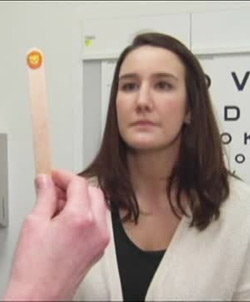 We’ve all heard a lot recently about the danger of concussions and how critically important it is to protect ourselves from repeated brain injury. Experts often use sophisticated equipment to measure concussion, but researchers in Pittsburgh have developed a simple test that is highly accurate, using items a doctor could carry in his pocket.
We’ve all heard a lot recently about the danger of concussions and how critically important it is to protect ourselves from repeated brain injury. Experts often use sophisticated equipment to measure concussion, but researchers in Pittsburgh have developed a simple test that is highly accurate, using items a doctor could carry in his pocket.
41-year-old Martin Rico was driving to the grocery store last year when another driver ran a stop sign and T-boned his car.
Rico told Ivanhoe, “It turned on its side, all the airbags came up, and I kind of hit my head.” Martin suffered a concussion.
“In the beginning, just opening my eyes for an hour would fatigue me,” he explained.
With a concussion, the brain has been shaken, and brain cells function differently.
Anne Mucha, DPT, Physical Therapist and Coordinator of Vestibular Rehabilitation at UPMC Sports Concussion Clinic in Pittsburgh, PA told Ivanhoe, “To have another injury on top of a concussion can potentially be very serious.”
Researchers have a new test to assess brain function after concussion. It’s called vestibular ocular motor screening, or VOMS.
“We look at how you tolerate focusing and moving your head. How you tolerate things moving around you,” Mucha said.
Using a metronome and a Popsicle stick with a small sticker, therapists ask patients to move their heads and focus their eyes on the image. Using a tape measure they check convergence, the point near the eyes where vision gets blurry.
Mucha says other concussion tests often miss subtle vision symptoms. She says VOMS is 90 percent accurate.
For Martin Rico, it meant therapists could tailor treatments to get rid of his remaining symptoms.
Rico said, “It’s night and day. I’m almost completely better after just a month.”
UPMC researchers say this test is accurate when patients are evaluated in a doctor’s office between one day and one week after a head injury. They have not used it to check for concussion immediately after impact so they don’t know at this point if this test could be used on the sidelines after a sports-related head injury.
Contributors to this news report include: Cyndy McGrath, Supervising/Field Producer; Cortni Spearman, Assistant Producer; Jamison Koczan, Editor and Kirk Manson, Videographer.